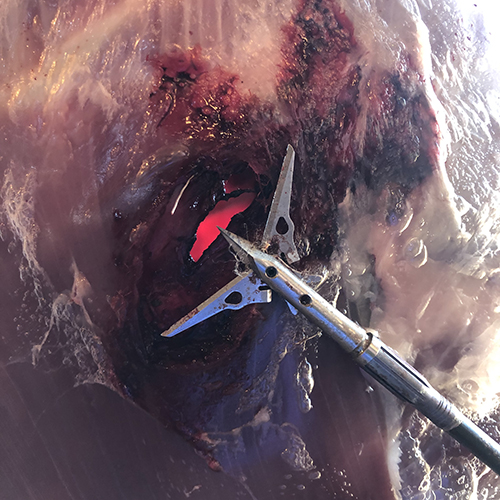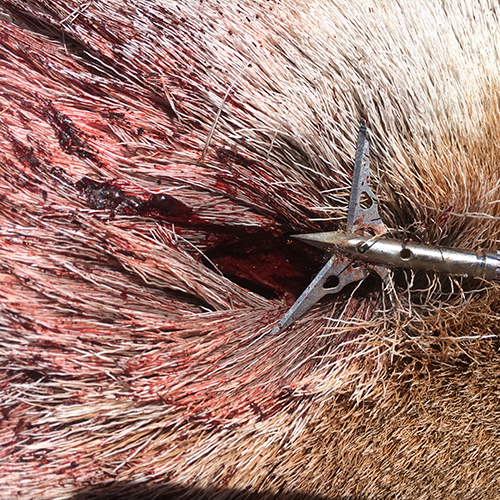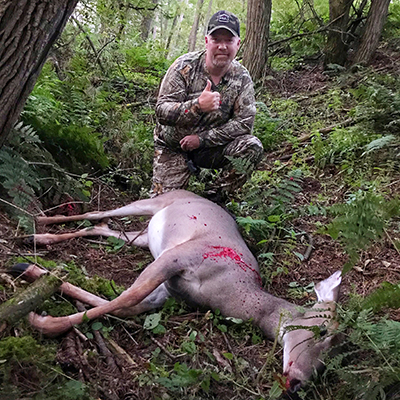I’m old. Really old. Old enough to have shot just about every name brand broadhead that’s come onto the scene since the 1970s. Truth be told, I had to be dragged kicking and screaming into the world of expandable broadheads. The earliest had problems, but as the years have gone by, mechanical design and manufacture has improved to the point where I’d shoot the very best of them at any big game animal in North America. Today most bowhunters agree, as they’ve made the modern mechanical broadhead the best-selling design type in America.
Here Comes SEVR
When mechanical SEVR broadheads first appeared last year, I was, of course, skeptical of them. They boasted they flew like field points (have we not heard that before?), penetrate anything and everything, and cut massive wound channels without fail. So, I thought, maybe I should give them a try. But before I took them afield, I needed to shoot them at home. A lot.
SEVR offers three basic heads: Ti 2.1 Max Cut (2.1-inch cutting diameter), Ti 1.5 Max Penetration (1.5-inch cutting diameter), and AP 1.7 (1.7-inch cutting diameter), designed as a head for both crossbow and compound bow shooters looking for a value broadhead. Both 100- and 125-grain Ti 2.1 and Ti 1.5 are available. The stand-out features include:
Lock-and-Pivot™ Blades: The patented Lock-and-Pivot™ non-barbed blades are fully contained in the ferrule, then lock open on impact. The blades then pivot as needed to keep arrows driving straight through game even on steep quartering shots and bone impacts. This increases penetration versus regular rear-deploy, non-pivoting broadheads.
Practice Lock™ Practice Mode: This patented feature keeps the blades locked and contained into the ferrule for practice and allows practice with the same broadheads you’ll take hunting, so you can verify true point-of-impact without dulling blades.
Stretch Cut™ Effect: Upon impact, SEVR’s Stretch Cut™ blade effect stretches the hide while cutting for a larger-than-blade wound diameter for bigger blood trails and easier recovery.
Titanium Ferrule: SEVR is billet-machined from Grade 5 Titanium with a precision-ground tip. Titanium provides a higher strength-to-weight ratio than steel for extreme durability and increased penetration.
Stainless Steel Blades: Both the 125- and 100-grain heads feature .032-inch thick stainless-steel blades that are fully contained in the ferrule to maintain sharpness and minimize drag for true field point accuracy.
Custom Quantities: You can buy SEVR broadheads in any quantity you wish, from one to as many as you want.
Crossbow Rated: SEVR heads are designed to perform with the fastest crossbows and will always remain closed in flight.
Replaceable Blade, Parts: Blades and other essential parts are replaceable.
Thread Options: Available in 100 and 125 grains in standard 8-32 threads. Deep Six thread available in 100 grains only.
Do They Work?
To paraphrase Donald Sutherland’s character, Vernon Pinkley, who said while he was impersonating a general and inspecting the troops in the classic 1967 movie, “The Dirty Dozen,” said: “Very pretty, colonel, very pretty. But can they fight?” I asked the same thing about SEVR broadheads. Do they fly? Will they penetrate deeply and cut a big hole? Will they hold up to serious abuse?

First off, I weighed every head. I had one dozen each of the 125-grain Max Cut and Max Penetration, and a dozen 100-grain Max penetration heads to play with. Using an electronic grain scale, and found the weights within +/- 1.0 grains of each other. That’s precision manufacturing!
I watched YouTube videos of SEVR heads being shot through just about everything except a Sherman tank, but of course I needed to try some stuff myself. So, while paper tuning two different bows with both the 100- and 125-grain Max Cut heads, I shot them both through the 2-inch thick cedar planks of my backyard fence at 15 yards. Guess what? I was not able to detect any damage whatsoever on either head.
Then I paper-tuned them. I am a fanatical paper tuner, and on both my bows I had to move my arrow rest just slightly to achieve the same bullet-hole tune I had with field points. Then I sighted the bows in, to 70 yards, first with field points, then broadheads. Both impacted the targets in the same place, time after time after time. I should mention that before practicing with the broadhead, I put it into “practice mode.” To do this you simply take the extra set screw that comes with each head and insert it into the ferrule just below the upper set screw, tighten it down, remove the rubber band, and BAM! The head can be shot for practice and the blades will not deploy, remaining razor sharp (and the blades are very, very sharp right out of the package.) To go hunting, remove this screw after replacing the rubber band and you’re off. How cool is that? You can sight in and practice with the exact same arrow/broadhead you’ll take hunting.
And this I did. I was going to hunt pronghorn with the 100-grain Max Cut, and elk with the 125-grain Max Cut, so I shot each of these heads into targets several hundred times each over the course of several months. Not once did the set screws need additional tightening, and they never wavered in their accuracy.
I set up two bows for two Western hunts this past September: a PSE Evoke 35 for pronghorn, and a Mathews Triax for elk. Both were set at 70 lbs. and loaded with Victory Archery VAP 350 shafts. The pronghorn shaft weighed in at 397 grains, while the elk shaft was right at 422 grains, and both were launched right at 275 fps.

I shot the pronghorn buck on a spot & stalk hunt at 58 yards through the right scapula. The broadhead blew right through the bone, cut through lungs and liver, and out the other side. Outfitter Scott Denny (Table Mountain Outfitters) called the 5×5 bull to 28 yards, slightly quartering to me, so I shot it through the left scapula. The broadhead blew through this thick bone, through lungs and liver, and stopped when it cut through an offside rib and poked a hole in the off-side hide. Both animals piled up within 60 seconds.
The autopsies showed tremendous performance from both broadheads. The onside hole was huge, the offside holes plenty big, and blood trails were easy to follow. Also, I cleaned up both heads, reinserted the blades back into the ferrule using the little red tool SEVR provides for this purpose, attached them to new shafts, spun-checked them for wobble. When I found none, I shot them at a target 20 yards away. Bullseye. I could hunt with both again after I touched the blades up a bit. That’s pretty amazing!
Any Problems?
My only issue with these heads is with the rubber O ring that secures the blades, and that issue is minor. I found that when inserting the heads into quiver foam, you had to be very careful not to put a lot of pressure on the blade’s front wing edges, or they’ll want to deploy the blades, which can snap the O ring. It’s something I was able to easily remedy by modifying one of the quivers I used, but there was no issue at all with my Mathews Arrow Web quiver.
Final Thoughts
You can’t buy SEVR broadheads anyplace except their website, where they are sold individually for $13.99 apiece (the AP 1.7 is $11.99), though currently if you order seven or more of either the 100- or 125-grain Ti versions, you’ll actually get one free. Each head comes individually packaged and includes the practice set screw, a couple of extra O rings, and a red broadhead wrench/wedge tool that will make it easy to snug deployed blades back into the ferrule.
I can’t wait to get them into the whitetail woods.


